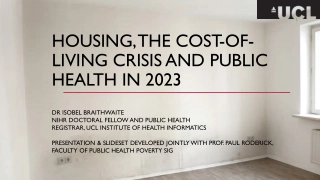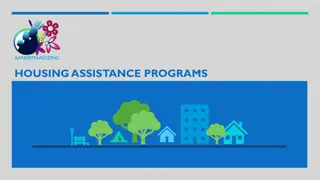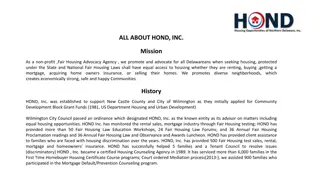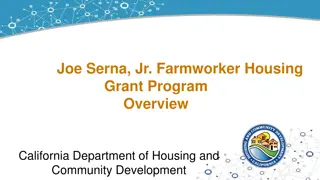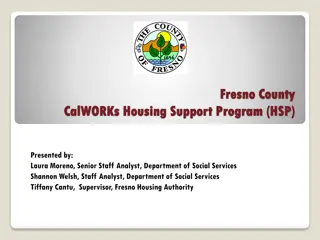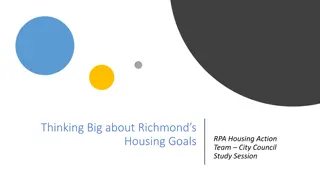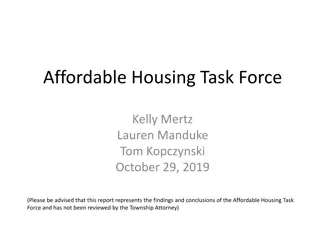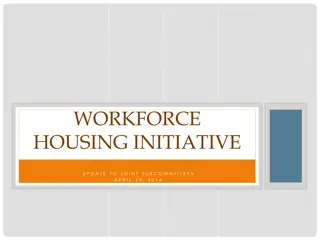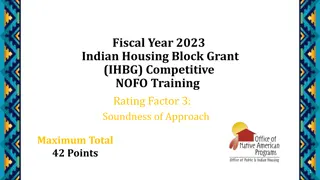CCBC Accessible Housing Service Overview
CCBC Accessible Housing Service in Caerphilly County Borough provides unified housing services catering to various tenures. Challenges include deprivation and topography. The service deals with housing options, strategy, and allocations, focusing on Welsh Housing Quality Standards. Private Sector Housing operations include adaptations and collaborations with Social Services. The Housing Strategy aims for 20,000 affordable homes by 2021 through partnerships with developers and Housing Associations, supported by local housing assessments. Language: English.
Download Presentation

Please find below an Image/Link to download the presentation.
The content on the website is provided AS IS for your information and personal use only. It may not be sold, licensed, or shared on other websites without obtaining consent from the author.If you encounter any issues during the download, it is possible that the publisher has removed the file from their server.
You are allowed to download the files provided on this website for personal or commercial use, subject to the condition that they are used lawfully. All files are the property of their respective owners.
The content on the website is provided AS IS for your information and personal use only. It may not be sold, licensed, or shared on other websites without obtaining consent from the author.
E N D
Presentation Transcript
CCBC Accessible Housing Service Claire Davies Interim Private Sector Housing Manager Sadie Cooper - Senior Practitioner Occupational Therapist Lauren Allman Therapist Occupational
CCBC Accessible Housing service Caerphilly County Borough Situated in South Wales valleys 5thlargest local authority in Wales with a population estimated to be 180,462 (2016). Shared directorate with Social Services Unified housing service Deal with all tenures of housing. Stock retaining
CCBC Accessible Housing Service At the time of the 2011 Census, there were 74,479 households in the County Borough. As shown below the majority of households own their own home, either outright or with a mortgage. 2011 Census
CCBC Accessible Housing Service Our challenges: Deprivation, topography of the area and type of stock. 2011 Census
CCBC Accessible Housing Service Census data * highlights that a higher proportion of the Welsh population (7.8%) consider themselves to be in poorer health compared to those in England (4.2%) * General Health in England & Wales: 2011 and comparison with 2001
Unified Housing Service Private Sector Housing Housing Options Housing Strategy Housing Allocations Public Sector Welsh Housing Quality Standards Housing Repairs operations
Private Sector Housing Deals with adaptations major and minor, works collaboratively with Social Services to owner occupiers, private rental sector via the DFG process. Caerphilly Homes stock via Housing Revenue Account funds adaptations for Local Authority tenants. Manage the Social Services budget to provide Minor works across tenure. Assist with relocations when accommodation has been deemed unsuitable to adapt. Provide an in-house agency service Housing OT
Housing Strategy Working to the delivery of 20,000 affordable homes by 2021. New housing developments:- 1- Work with private developers through the planning process via section 106 agreements. 2- Management of Social Housing grant. Work in partnership with Housing Associations. 3- Other Housing funds i.e., Health and Housing and Innovative Housing. Local Housing Market Assessment identifies housing need. CHR information provided used to asses need and demand for social housing.. Housing OT
Public Sector Local landlord Service 10802 Properties in the Borough
Housing Repairs Operations Servicing and Maintenance which includes all ceiling track hoists (private & Public) and all lifts in council stock i.e. stair lift, vertical lifts etc. Housing OT assists with reassessments of hoists/lifts when not repairable & Housing OT considers if existing adaptations need to be recycled i.e. removed from property. Re-use of recycled lifts from private sector into public sector.
Welsh Housing Quality Standards Large scale improvements across the whole of the Borough, OT assessment identifies provision of bathrooms, kitchen, access etc. suitable to need of tenant. OT assessment with all sheltered schemes across the Borough Housing OT works with colleagues when inappropriate housing/need to transfer is identified.
Housing Options Help with housing problems in areas including e.g., homelessness, renting, debt. Applying for emergency accommodation. Link with Housing OT to ensure property offered meets medical needs.
Housing Allocations Process the Common Housing Register applications. Includes Senior CHR officer & team of 4 CHR officers. Housing OT s Mental Health assessor (Gofal)
CCBC Common Housing Register. Operational since Dec 2016 Website launched Home search Caerphilly a dedicated website aimed at providing information on the different housing options available in Caerphilly County Borough. Equality Impact Assessment prior to CHR to ensure an equitable service. 1 register for all applicants CCBC properties & 6 HA partners 1 Common Allocation Policy Accessible housing register sits within the register CCBC CHRAO s deal with all applications All partners shortlist and offer accommodation
CHR Process Application online information required about the applicants and their housing needs. Also promote support with completing application if difficulties identified i.e., telephone application with CHRAO, support sessions in local Libraries through the Borough, customer service and home visits. Information section with regards to an applicant/s health and physical difficulties & Information section with regards to an applicant/s mental health
CHR process CHRAO completes all necessary checks i.e. proof of identify, Child benefit etc.. HOT & MHA complete assessments desk top, home visits, joint working with other professionals ie hospital/community professionals. Currently working within a 4 week time frame. HOT assessments determine level of accessibility required and band. Application updated by CHRAO and applicant is ready for shortlisting.
Level of Accessibility Person Classification from A to D A1 Independent wheelchair user. Will require ground floor accommodation or vertical lift access to alternative floors. Access to property must be level or ramped to a minimum 1:12. The accommodation will need to be entirely wheelchair accessible i.e. door widths to a minimum of 780mm Dependent wheelchair user. Will require ground floor accommodation or A2 vertical lift access to alternate floors. Access to the property must be level or ramped to a maximum of 1:12. Internally full access to the property may not be necessary but essential rooms will need to have door widths of 780mm.
Level of accessibility B1 Semi ambulant person who is unable to negotiate steps or stairs or who is dependent on a wheelchair out of doors. The property will need to be ground floor or have either stair lift or vertical lift access to alternate floors. Access to the property will need to be level or ramped to a minimum of 1:12 B2 Semi ambulant person who is able to negotiate a limited number of steps. The property may be ground floor or have either stair lift or vertical lift access to alternate floors. Access to the property does not needs to be level but should have a limited number of steps with hand rail provision.
Level of Accessibility C An ambulant person who is able to negotiate steps and stairs on a limited basis. D A physically abled person U An applicant who has indicated health issues but is waiting for assessment. This ensures applicant does not miss out on an opportunity.
CHR Banding system CHR policy based on simplified banding system, placed into one of three bands depending on an assessment of their circumstances those with the greatest need afford the highest priority. It is a needs based, time and date ordered system. The allocation scheme has been designed to ensure that reasonable preference is given to the following categories of people i.e. homeless, those owed a duty by the LA, insanitary conditions, over crowding issues, medical grounds/disability & hardship. Additional preference can also be awarded to those who fall within the reasonable preference categories and who have urgent housing needs.
CHR Banding system Band 1 Urgent need to move (Reasonable preference plus additional preference) e.g., Hospital discharge, emergency medical or disability, release of adapted property, Armed forces, Homeless with a duty secured etc. - Jan 2018 3.20% Band 2: Need to move Reasonable preference e.g., Housing conditions exacerbates a serious medical condition or disability, Homeless or threatened with homeless. Jan 2018 34.34% Band 3: Wants to move no reasonable or additional preference. Jan 2018 - 59.45% The remaining 3.01% -relates to incomplete applications.
Categorisation of properties Every property must have a level of accessibility category Mandatory field in the IT system Abritas. Essential to enable a void property to be allocated. Property category has a corresponding shortlisting criteria.
Adapted or accessible ? What makes a property adapted? E.g., Stair lift, Vertical lift, Low level Shower What makes a property Accessible ? Level access, widened doorways, adequate circulation space, location.
Category A A wheelchair accessible highly adapted or purpose built property, allowing wheelchair access internally and externally. 2 Subcategories A1 wheelchair access throughout the property A2 Not all the rooms within the property are wheelchair accessible Bungalow, Ground floor flat, first floor flat with vertical access or 2 storied house with vertical lift allowing access to first floor
Category B A property not wheelchair accessible internally but affords good graded access and when necessary is suitable for provision of vertical lift or stair lift. 2 subcategories B1 A property allowing external but not internal wheelchair access. B2 A property with maximum of 2 steps to main entrance. Bungalow, Ground floor flat, first floor flat with vertical/stair lift access or 2 storied house with vertical/stair lift allowing access to first floor
Category C A property that facilitates limited use of stairs and steps. A property in which lift provision is not possible and has maximum of 5 steps to main external access. 3 sub categories: C1 First floor property so providing all facilities on one level. C2 A two stored house with WC facilities to both levels C3 A ground floor flat or bungalow
Category D Suitable for general needs In excess of 5 steps. Not suitable for allocation to a person with physical disabilities. Property not suitable for adaptations.
Coding the properties. Council stock is coded by the Estate Management Officers who are locally based to their area s. Housing Officer for the Housing Associations code their stock. HOT s provided training prior to CHR Code reflects best match Ongoing OT advice for coding properties
Coding properties CCBC properties across borough by medical category Abritas report % Medical Category Total A1 FULL WHEELCHAIR 274 2.5 A2 PARTIAL WHEELCHAIR 173 1.6 B1 LEVEL/RAMPED 1093 10.1 B2 LIMITED STEPS 573 5.3 C1 SINGLE LEVEL FAC 546 5.1 C2 HOUSE WC X 2 350 3.2 C3 LEVEL FAC GF ONLY 139 1.3 D NOT ADAPTABLE 1542 14.3 Not categorised 6112 56.6 Total 10802 100
Action for the future. Development of central repository for all CHR stock This will include type of property and the medical code, property information etc. Number of properties coded will increase showing a more accurate stock profile throughout Borough. Ability to compare what exists against unmet need. Highlight what properties are required moving forward i.e. consider Enable funding, areas of high demand and new developments etc.
Benefits of Accessible housing register. Right person to the right property. Maximise independence. Reduce demands on health service Promotion of peoples well being Maximise use of our existing resources Information from CHR can provide information requires at strategic level Minimal refusals
Benefits of Accessible housing register Minimal refusals Policy allows 3 reasonable refusals. Refusals A1 3 1 A2 3 B1 37 7 2 1 B2 33 8 2 1 C1 5 C2 11 2 C3 32 7 2 D U 3 2 Total 312 63 21 6 1 1 offer refused 2 offers refused 3 offers refused 4 offers refused 5 offers refused Total 185 36 15 4 1 251 4 3 47 44 5 13 41 5 403
CHR 1 Year on. Applicants on waiting list by age group and medical category. Age Group A1 A2 B1 B2 C1 C2 C3 D U Total 16-29 1 6 13 2 24 2 1127 10 1185 0 30-44 7 5 26 43 9 39 15 1005 19 1168 45-59 6 12 65 132 25 56 81 596 36 1009 60-74 9 12 127 269 14 25 192 337 34 1019 75+ 1 15 94 128 5 57 144 11 455 0 Total 24 44 318 585 55 144 347 3209 110 4836
CHR 1 year on Introduction of the U code. Better informed about who needs what & where. Unmet needs. Reregistration. Review and monitor applicants on the register Better understanding of the stock profile Development of communication with all staff
Next steps & future challenges Rapidly ageing society, how to meet future demands. Work seamlessly & provide joined up services. Respond to identified needs and deliver timely housing solutions. Make best use of already adapted properties. Engagement with health bodies. Forecasting future demand. On going involvement with tenant information exchange and consideration for representative to be involved with accessible housing and future developments.
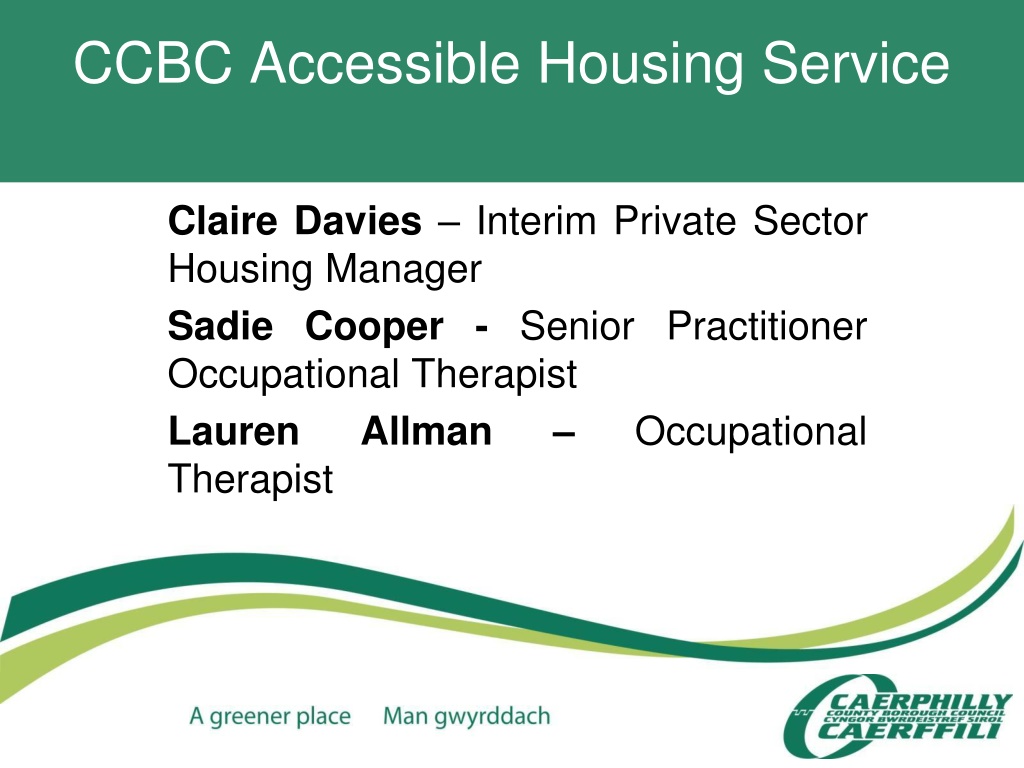
 undefined
undefined



